RBSE Class 12 Biology Important Questions Chapter 2 Sexual Reproduction in Flowering Plants
Rajasthan Board RBSE Class 12 Biology Important Questions Chapter 6 Molecular Basis of Inheritance Important Questions and Answers
Rajasthan Board RBSE Solutions for Class 12 Biology in Hindi Medium & English Medium are part of RBSE Solutions for Class 12. Students can also read RBSE Class 12 Biology Important Questions for exam preparation. Students can also go through RBSE Class 12 Biology Notes to understand and remember the concepts easily. Browsing through manav janan class 12 in hindi that includes all questions presented in the textbook.
RBSE Class 12 Biology Chapter 2 Important Question Sexual Reproduction in Flowering Plants
Multiple Choice Questions
Question 1.
The petal is the unit of:
(a) calyx
(b) corolla
(c) androecium
(d) gynoecium
Answer:
(b) corolla

Question 2.
Monothecous anthers are found in which of the following?
(a) Braasica
(b) Pisum
(c) Hibiscus
(d) Solanum nigrum
Answer:
(c) Hibiscus
Question 3.
Tapetum is:
(a) outer layer of pollen sac
(b) middle layer of pollen sac
(c) third layer of pollen sac
(d) innermost layer of pollen sac
Answer:
(d) innermost layer of pollen sac
Question 4.
Embryo sac is found in:
(a) endosperm
(b) embryo
(c) ovule
(d) seed
Answer:
(c) ovule
Question 5.
When pollen tube enters through integument, this process is called:
(a) mesogamy
(b) porogamy
(c) chalazogamy
(d) pseudogamy
Answer:
(a) mesogamy
Question 6.
When pollination takes place by bats is called:
(a) ornithophily
(b) chiropterophily
(e) entomophily
(d) anemophily
Answer:
(b) chiropterophily
Question 7.
Theexine of pollen grain is made of:
(a) cellulose
(b) sporopollenin
(c) liginin
(d) pectocellulose
Answer:
(b) sporopollenin
Question 8.
Sometimes pollen grains affect the endosperm in angiosperms. This phenomenon is called:
(a) Xenia
(b) Metaxenia
(c) protandry
(d) Endrogeny
Answer:
(a) Xenia
Question 9.
The bisexual flower which never open represent:
(a) allogamy
(b) autogamy
(c) cleistogamy
(d) None of these
Answer:
(c) cleistogamy
Question 10.
Filliform apparatus is a characteristic feature of:
(a) nucellar embryo
(b) generatice cell
(c) aleurone cell
(d) synergids
Answer:
(d) synergids
Question 11.
Development of embryo sac from nucellar cells is called:
(a) diplospory
(b) apospory
(c) adventive embryony
(d) apogamy
Answer:
(b) apospory
Question 12.
Perisperm is:
(a) remains of nucellus
(b) outer part of embryo sac
(c) degenerated synergids
(d) degenerated secondary nucleus
Answer:
(a) remains of nucellus
Question 13.
Polygonum type of embryo sac is:
(a) monosporic octa nucleate
(b) monosporic tetra nucleate
(c) bisporic octa nucleate
(d) bisporic tetra nucleate
Answer:
(a) monosporic octa nucleate
Question 14.
Ubish bodies are associated with the development of:
(a) embryo sac
(b) pollen grains
(c) endosperm
(d) embryo
Answer:
(b) pollen grains

Question 15.
The process of double fertilization was discovered by:
(a) G. Domagk
(b) S.G. Nawaschin
(c) Leeuwenhock
(d) O. Smith
Answer:
(b) S.G. Nawaschin
Question 16.
The edible part of apple fruit is:
(a) ovary
(b) seeds
(c) flashy thalamus
(d) placenta
Answer:
(c) flashy thalamus
Question 17.
When pollen tube enters through micropyle then the process is called:
(a) Porogamy
(b) Mesogamy
(c) Chalazogamy
(d) Apogamy
Answer:
(a) Porogamy
Question 18.
Double fertilization involves:
(a) Fertilization of egg by two gametes
(b) Fertilization of two egg in the same embryo sac by two sperms brought by one pollen tube
(c) Fertilization of egg and central cell by two sperms brought by different pollen tube
(d) Fertilization of egg and central cell by two sperms brought by same pollen
Answer:
(d) Fertilization of egg and central cell by two sperms brought by same pollen
Question 19.
Through which cell of the embryo sac does the pollen tube enter the embryo sac?
(a) Egg cell
(b) Central cell
(c) Persistent Synergid
(d) Degenerated Synergid
Answer:
(d) Degenerated Synergid
Question 20.
Transfer of pollen grains from one flower to another flower of same plant is called:
(a) gietonogamy
(b) autogamy
(c) allogamy
(d) cleistogamy
Answer:
(a) gietonogamy
Question 21.
Wind pollination is common in:
(a) Legumes
(b) Lilies
(c) Grasses
(d) Orchides
Answer:
(c) Grasses
Question 22.
In some plants anthers and stigma grow and mature at the same time. This phenomenon is known as :
(a) homogamy
(b) syngamy
(c) allogamy
(d) fusion
Answer:
(c) allogamy
Question 23.
In natural cleistogamous flowers are:
(a) wind pollinated
(b) bird pollinated
(c) self pollinated
(d) insect pollinated
Answer:
(d) insect pollinated
Question 24.
Triploid tissue in angiosperm is:
(a) nucellus
(b) endosperm
(e) endothecium
(d) tapetum
Answer:
(b) endosperm
Very Short Answer Type Questions
Question 1.
How many types of reproduction does take place in angiosperme?
Answer:
There are two types of reproduction takes place in angiosperms: sexual reproduction and asexual reproduction.
Question 2.
Define geitonoganly?
Answer:
A type of self pollination in which pollen grains are transferred from anther of one flower to stigma of another flower born on the same plant is called geitonogamy.
Question 3.
What do you mean by chiropterophily?
Answer:
Pollination brought about by bats is called chiropterophily.
Question 4.
What is coleorrhiza?
Answer:
A protecticecovering around redicle and root cap in monocot embryo is called coleorrhiza.
Question 5.
What is scutellum?
Answer:
A single cotyledon in monocot embryo is called scutellum.

Question 6.
What is parthenocarpic fruit?
Answer:
Fruits that are developed without the act of fertilization are called parthenocarpic fruits.
Question 7.
What is malacophily?
Answer:
Pollination brought about by molluscs is known as malacophily.
Question 8.
Name the protective substance present in the pollen envelop to tide over adverse condition.
Answer:
Sporopollenin.
Question 9.
Define anemophily.
Answer:
Pollination brought about by wind is known as anemophily.
Question 10.
What is the fate of haploid megaspores formed from megaspore mother cell in an angiospermic plant?
Answer:
Out of four megaspores, one becomes functional and forms embryo sac. Rest of three degenerate.
Question 11.
Give one example of dicot endospermic seed.
Answer:
Castor seed.
Question 12.
What is funiculus?
Answer:
Funiculus is the stalk of ovule.
Question 13.
Name two plants which bear anemophilous flowers.
Answer:
- Zea mays (Maize)
- Doob grass (Cynodon).
Question 14.
Write two characteristics of flowers pollinated by insects.
Answer:
- Flowers are usually large, bright coloured.
- They are scanted and produce nectar to attract insects.
Question 15.
What is germpore?
Answer:
A pore present in exine of pollen grain is called germ pore through which pollen tube emerges.
Question 16.
What is the function of plumule?
Answer:
Plumule produces shoot system.
Question 17.
What is parthenogenesis?
Answer:
Parthenogenesis is the method of reproduction, in which eggs or female gametes develop into new plants without fertilization.
Question 18.
What is aponilxis?
Answer:
Apomixis is a process of reproduction in which embryo is formed wihout fertilization.
Question 19.
What is function of endosperni?
Answer:
The function of endosperm is to provide nourishment to embryo.
Question 20.
Name the type of flower which favours cross pollination.
Answer:
Chasmogamous flower.
Question 21.
Write the function of coleoptile.
Answer:
Coleoptile protects the plumule of the monocot embryo.
Question 22.
Angiosperms bearing unisexual flowers are said to be either monoecious or dioecious. Explain with the help of one example each.
Answer:
Plant bearing flowers of both sexes, i.e., staminate and pistillate flowers called monoecious. e.g., Zea mays. When both sexes are present on different p1ant; they are called dioecious plants. e.g., Carica papaya.
Question 23.
Gynoecium of a flower may be appocarpous or syncarpous. Explain with the help of an example each.
Answer:
Gynoecium of a foyer is called as apocarpous when the carpels are free, e.g., in Ranunculus. Whereas it is called syncarpous when the carpels are fused. e.g., in Petunia.
Question 24.
Write one advantage and one disadvantage of cleistogamy to flowering plant.
Answer:
The advantage of cleistogamy is that is ensures pollination in the absence of pollinators. Disadvantage if cleistogamy is that there is no chance of variations to occur.
Question 25.
Name any two false fruit.
Answer:
- Apple fruit
- Pear fruit.
Question 26.
What is microsporogenesis?
Answer:
The development of microspores is called microsporogenesis.
Question 27.
What is the first cell of male gametophyte?
Answer:
Microspore is the first cell of male gametophyte.
Question 28.
Who coined the term double fertilization?
Answer:
S.G. Nawaschin coined the term double fertilization.
Question 29.
Why do pollen grains remains preserved for long time?
Answer:
The pollen grains have a tough outer wall mode of cellulose and sporopollenin. This provides protection to the pollen grains.
Question 30.
What is emasculation?
Answer:
Removal of stamens in bud condition is called emasculation.
Question 31.
Define embryogenesis.
Answer:
Development of embryo from diploid zygote is known as embryogenesis.
Short Answer Type Questions - I
Question 1.
Name four whorls of a typical flower and mention the function of each whorl?
Answer:
Whorls of the flower:
- Calyx: It protects floral parts in bud condition.
- Corolla: It attracts pollinators to pollination.
- Androeclum: It produces pollen grains.
- Gynoeclum: It produces eggs.
Question 2.
What is perienth?
Answer:
In some plants calyx and corolla are not clearly differentiated in this condition they are collectively called perienth. Its individual unit is called tepal. Tepals may be gamotepalous or polytepalous. Green tepals are known as sepaloid and coloured tepals are called petaloid. Parienth is found in the plants of poaceae and Liliaceae families.
Question 3.
Enumerate any six adaptive floral characteristics of wind polilnated flower.
Or
How does the study of different parts of a flower help in identifying in wind as its pollinating agent.
Answer:
Adaptive floral characteristics of wind pollinated flower:
- The flowers are small and inconspicuous.
- The pollen grains are light and non - sticky so that they can be easily transported by wind.
- They have well - exposed stamens so that pollen grains get easily dispersed.
- They often have feathery stigma to catch the pollen grains.
- The pollen grains are dry and unwettable to prevent pollens from gaining moisture from air.
- The pistil usually has single ovule in each ovary.
Question 4.
Write briefly the role of pollination In the growth and development in an angiospermic plant.
Answer:
Pollination is the transfer of pollen grains fromanthers to the stigma of a flower. Pollination is prerequisite for fertilization, events after fertilization like endosperm development, seed seedling and fruit formation. Thus, pollination plays an important role in the growth and development of angiospermic plants.

Question 5.
Why are angiosperm anther called dithecous? Describe the structure of its microsporangium.
Answer:
The anthers of angiosperms are called dithecous because they are bibbed and each lobe of anther has two theca. Microsporangium is surrounded by four wall layers named as epidermis, endothecium, middle layer and tapetum. In young anther, a group of compactly arranged homogenous cells called sporogenous tissue occupies the centre of each microsporangium which produce microspores or pollen grains.
Question 6.
Which type of ovule is shown in the following figure? Give one reason.
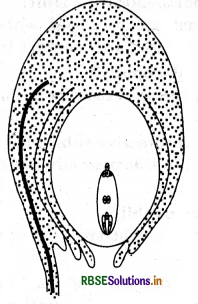
Answer:
Anatropous (inverted) ovule.
Reason: Funicle is fused ith the body of the ovule with basal chalaza at one end and apical micropyle at the other end (near the hilum).
Question 7.
In the T.S. of a mature anther identify ‘A’ and ‘B’. Mention their functions.
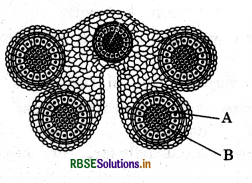
Answer:
A. Sporogenous tissue.
Function: Formation of microspore mother cell and after their meiosis production of microspores (pollen grains).
B. Tapetum
Function: It provides nourishment to the developing pollen grain.
Question 8.
Where is sporopollenin in plants. State its significance with reference to its chemical nature.
Answer:
Sporopollenin is present in the exine of pollen grains. It is the most resistant organic material in nature. It provides protection to the pollen from unfavourable conditions or chemicals (acids, enzymes and high temperature).
Question 9.
Draw a diagram of a male gametophyte of angiosperm. Label any four parts. Why is sporopollenin considered the most organic material?
Answer:
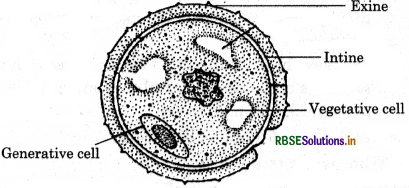
Sporopollenin is considered the most resistant organic substance because it can withstand high temperatures and action of strong acids and alkalis. Also cannot be degraded by any enzyme.
Question 10.
How is pollination carried out in water plants?
Answer:
Pollination in aquatic plants:
- By insects or wind in water hyacinth and. water lily.
- By water in vallisneria: male flower brought close to female flower on water surface and pollen grains are carried passively by water currents to reach stigma.
Question 11.
What is the function of the two male gametes produced by each pollen grain in angiosperms?
Answer:
One male gamete fuses with the egg to produce the zygote and second male gamete fuses with the two polar nuclei to produce triploid endosper.
Question 12.
Write two differences between plants those of pollinated by insects and wind.
Answer:
Difference between insect pollinated and wind pollinated plants:
|
Insect Pollinated Plants |
Wind Pollinated Plants |
|
1.They have large, coloured and conspicuous flowers. |
1. They have small, colour: less and inconspicuous flowers. |
|
2. Pollen grains are sticky and stigma is also sticky. |
2. Pollen grains are non - sticky and stigma is feathery. |
Question 13.
Draw a diagram of a section of a megasporangium of an angiosperm and level funiculus, micropyle, embryo sac and nucellus.
Answer:
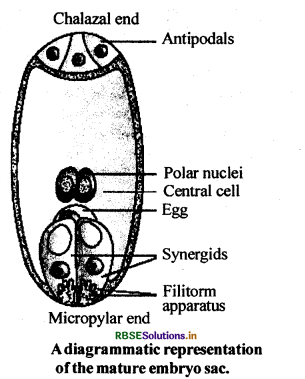
Embryo sac (or female gametophyte) is formed by three successive mitotic divisions that take place in the nucleus of megaspore.
The nucleus of the functional megaspore divides meiotically to form two nuclei which move to the opposite poles, forming the 2-nucleate embryo sac. Two more sequential mitotic nuclear divisions result in the formation of the 4 - nucleate and later the 8-nucleate stages of the embryo sac. After the 8 - nucleate stage, cell walls are laid down leading to the organisation of the typical female gametophyte or embryo sac. Six of the eight nuclei are grouped together at micropylar and chalazal end and form the egg apparatus and antipodals respectively. The large central cell left over with two polar nuclei. Thus, a typical female gametophyte consists of 7 cells with 8 nucleus.

Question 14.
Explain the process of pollination in Vallisneria.
Answer:
Water Pollination or Hydrophily: The transfer of pollen grains from anther to stigma by means of water is called hydrophily. All aquatic plants are not hydrophilous. For example, aquatic plants, Alisma and Nymphaea are entomophilous plants, while Potamogeton and Myriophyllum are anemophilous.
Characteristics of hydrophilous flowers are:
- They are small and inconspicuous.
- They are nectarless, colourless and odourless.
- Univettable perianth, other floral parts and pollen graine.
- The pollen grains of these flowers are light but covered with wax.
- Long and sticky stigma.
Examples of Hydrophily: Vallisneria, Hydrilla, Zostera, Ceratophyllum etc.
Hydrophily is of two types:
(a) Hypohydrophily: It occurs in totally submerged plants such in Zostera, Ceratophyllum etc.
(b) Epihydrophily: It occurs in those aquatic plants where flowers remain at the surface of water as in Vallisneria.
In vallisneria, the plants are dioecious, i.e., the male flowers are small, short - stalked and produced in large numbers. These flowers are surrounded by a spath under water. The female flowers, on the other hand, are solitary are borne on long and coiled stalks. On maturing, male flowers get detached from plant and float on the surface of water owing to the opening of the perianth into a boat - like structure.
At the same time, female flower rises to the water surface by the straightening of stalk. As the male and female come in ontact, male flower is drawn in the depression of female flower and anthers come in contact with the large trifid stigma of female flower. They burst liberating pollen grains which stick to the stigma. After pollination, the female flower and close and their long stalks curl up, drawing the flowers below the surface of water down in the mud where the seeds and fruits developed.

Question 15.
A pollen grain in angiosperm at the time of dehiscence from an anther could be 2 - celled or 3 - celled. Explain, how are the cells placed within
the pollen grain when shed at a 0.2 - celled stage?
Answer:
Each mature pollen grain in angiosperms have a generative cell and a vegetative cell. In about 60% of angiosperms, pollen grains are shed at this 2 - celled stage. However, in about 40% flowering plants, the generative cell may further divide mitotically to give rise to two male gametes and pollen grains and shed at this 3 - celled stage. The placement of cell within the pollen grain when shed at two - celled stage can be visualised as shown below:
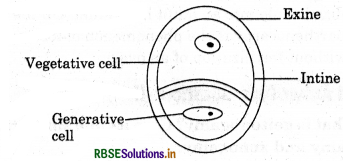
Question 16.
You are conducting artificial hybridisation on papaya and potato. Which one of them would require the step of emasculation and why? However for both you will use the process of bagging? Justify giving one reason.
Answer:
Papaya produces unisexual flowers and potato produces bisexual flowers. Therefore, the step of emosculation will be done on potato because emosculation is done on bisexual flowers to avoid self pollination. But, bagging is done on unisexual flowers, so to dust suitable pollen grains on the stigma when the stigma turns receptive and the flowers are rebagged.
Question 17.
It is said apomixis is a type of asexual reproduction. Justify.
Answer:
Through, apomixis, viable seeds can be produced without fertilization and zygote formation through gametic fusion. This is not the case during sexual reproduction. In sexual reproduction, seeds are produced through gametic fusion following fertilization. So, apomixis is called a type of asexual reproduction.
Question 18.
Name the post fertilization events in angiosperms.
Answer:
Post fertilization events in angiosperms:
- Development of endosperm.
- Development of embryo.
- Seed formation.
- Fruit formation.
Question 19.
Draw a diagram of pollen grain with germ tube and two male gametes.
Answer:
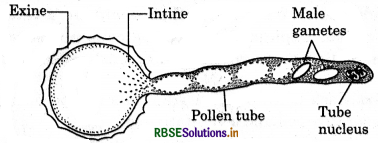
Question 20.
What is aganiospermy? How is agamospermy different from parthenogenesis and parthenocarpy?
Answer:
The phenomenon of asexual reproduction that mimic sexual reproduction as forms seed without fertilization is known as agamospermy. Parthenogenesis refers to the development of unfertilized ovule into an adult individual. On the other hand, parthenocarpy is the phenomenon of formation of fruits without fertilization of an ovary.
Short Answer Type Questions - II
Question 1.
What is geitonogamy? Give its one similarity to autogamy and xenogamy.
Answer:
Geitonogamy is a type of pollination in which pollen grains of a flower are transferred to the stigma of another flower of the same plant.
Similarity of autogamy: Geitonogamy is genetically similar to autogamy in the respect that pollen grains are transferred to stigma of the flower, but on the same plant so both are genetically similar whereas autogamy found in bisexual flowers.
Similarity to Xenogamy: Geitonogamy is similar to xenogamy in the respect that pollen grains are transferred to stigma of different flower.
Question 2.
Give two examples of each:
(a) Anemophilous plants
(b) Hydrophilous plants
(c) Entomophilous plants
(d) Ornithophilous plants
(e) Chireptorophilous plants
(f) Malacophilous plants
Answer:
(a) Coconut, Canabis
(b) Hydrilla, Vallisneria
(c) Baugainvillea, Dahlia
(d) Agave, Bornbax
(e) Adansonia, Kingelia
(f) Chrysanthemum, Arum lily.
Question 3.
Explain any three advantages the seeds offer to angiosperms.
Answer:
- Since reproductive process such as pollination and fertilization are independent of water, seed formation is more dependable.
- Seeds have better adaptive strategies for dispersal to new habitates and help the species to colonise in other areas.
- As they have sufficient food reserves young seedlings are nourished until they are capable of photosynthesis on their own.

Question 4.
(a) What is double fertilization?
(b) What is the triple fusion?
(c) What is the significance of double fertilization?
Answer:
(a) Double FertilIzation: In all angiosperms, two male gametes are formed in a pollen tube. At the time of fertilization, one of them fuses with the egg nucleus to form zygote and other with secondary nucleus to form primary endosperm nucleus. Due to it this, fertilization is called double fertilization.
(b) Triple Fusion: Triple fusion involves fusion of two polar nuclei to form secondary nucleus (diploid) and its fusion with second male nucleus. This forms a triploid endosperm nucleus.
(c) Significance of Double FertIlization: As a result of double fertilization a diploid zygote (2n) and a triploid endosperm nucleus are formed. The former develops into embryo and letter forms endo sperms.

Question 5.
Differentiate the following:
(a) Chasmogamous flowers and Cleistogamous flowers.
(b) Autogamy and geitonogamy.
(c) True and False fruits.
Answer:
(a) Difference between Chasmogamous flowers and Cleistogamous flowers.
|
Chasmogamous Flowers |
Cleistegamous Flowers |
|
1. Flowers open exposing anther and stigmas. |
1.Flowers remain closed throught. |
|
2. Both self and cross pollination occur. |
2. Only self pollination occur. |
|
3. Flowers require pollinating agency. |
3. No pollinating agency is required. |
(b) Difference between Autogamy and geitonogamy
|
Autogamy |
Geitonogamy |
|
1. For autogamy, the flowers should be hermaphrodite. |
1. For geitonogamy, the flowers should be unisexual. |
|
2. It involves transfer of pollen grains from anther to stigma of the same flower. |
2. There is transfer of pollen grains from anther of one flower to stigma of another flower. |
|
3. No external agency is required for pollination. |
3. Some external agency is required for pollination. |
(c) Difference between True and False friuts
|
True Fruits |
False Fruits |
|
1. They develop from ovary oily. |
1. Alongwith ovary some additional parts of a flower or inflorescence grow to form the false fruits. |
|
2. Pericarp forms the outer part of the fruit. |
2. The outer part of fruit is formed by thalamus. |
Question 6.
Look at the figure and label the following:
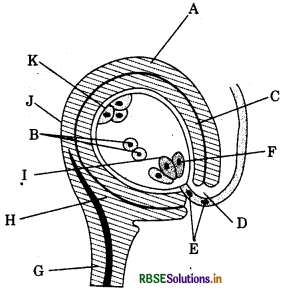
Answer:
A. Nucellus
B. Secondary nucleus
C. Integument
D. Micropyle
E. Male gamete
F. Synergid cell
G. Funiculus
H. Hilum
I. Egg cell
J. Raphe
K. Antipodal cell.
Question 7.
What does an interaction between pollen grains and its compatible stigma result in after pollination? List two steps in sequence that follows
after the process.
Answer:
When the pollen grains fall on the stigma, they germinate and pollen tube enters one of the synergids and releases two male gametes:
- One of the male gametes move towards the egg cell and fuses with it to complete syiigamy to form the zygote.
- The second male gamete fuses with the two polar nuclei and forms primary endosperm nucleus (3n). This is termed as triple fusion.
- Since two kinds of fusion - syngamy and triple fusion takes place, the process is called double fertilization and is characteristics of flowering plants.
Question 8.
(i) Can a plant flowering in Mumbai be pollinated by pollen grains of the same species growing in New Delhi? Provide explanation to your answer.
(ii) Draw the diagram of a pistil where pollination has successfully occurred. Label the part involved in reaching the male gametes to its desired
destination.
Answer:
(i) Yes, the plant flowering in Mumbai can be pollinated by pollen grain of the same species growing in New Delhi. It is mainly because there are certain agents of pollination that can carry pollen grains to long distance. Plants can use either abiotic or biotic agencies for pollination. Abiotic pollinators include wind and water while biotic pollinators are, insects, birds, bats and even humans. It is believed that pollination by wind is more common because transport by wind - current can take pollens to distance places.
(ii)
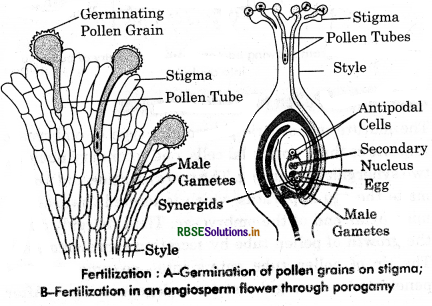
Question 9.
Flowering plants have developed many devices to discourage self - pollination and to encourage cross - pollination. Explain three such devices.
Answer:
Hermaphrodites or bisexual flowers develop outbreeding devices to ensure cross - pollination and avoid self - pollination. The three outbreeding devices that flowering plants have developed to discourage self - pollination are:
1. Unisexuality (dicliny): Flowers are unisexual, so that self - pollination is not possible. The plants may be monoecious (bearing both male
and female flowers e.g., Maize) or dioecious (bearing male and female flowers on different plants e.g., Papaya, Mulberry).
2. Dkhogamy: Anther and stigma mature at different time in a bisexual flower for preventing self - pollination.
(a) Protandry: Anthers mature earlier than stigma of the same flower. The pollens thus become available to stigmas of the older flowers. e.g.,
Salvia, Sunflower.
(b) Protogyny: Stigma mature earlier, so that they get pollinated before the anthers of the same flower develop pollen grains. e.g., Plantago,
Mirabilis.
3.The third device to prevent self - pollination is self - incompatibiity. it is a genetic mechanism that prevents self - pollen from fertilizing the ovule by preventing pollen germination or pollen tube growth in the pistil. All these methods encourage cross - pollination thus causing genetic variations among them.
Question 10.
Do you think apomixis can be compared with asexual reproductions? Support your answer, giving one reason. How is apomixis beneficial to
farmers? Explain.
Answer:
Yes, apomixis can be compared with asexual reproduction. It is also called a form of asexual reproduction that mimics sexual reproduction. In
apomixis, seeds are produced without fertilization and zygote formation through gametic fusion. So, it can be called as a form of asexual reproduction.
Two advantages of apomictic seeds (apomixis) to farmers are:
- It lowers the cost of production.
- Apoimictic seeds do not have to be produced every year.
Question 11.
(i) Differentiate between geltonogamy and Xenogamy.
(ii) Write the difference in the characteristics of the progeny produced as a result of the two processes.
Answer:
(i) Difference between geitonogamy and xenogamy are:
|
Geltonegamy |
Xenogamy |
|
1. It is the transfer of pollen grains from the anther to the stigma of another flower of same plant. |
1.It is the transfer of pollen grains from the anther to the stigma of different plants. |
|
2. The pollen grains are genetically similar to the plant. |
2. The pollen grains are genetically different from the plant. |
(ii) Geitonogamy results in progenies which are pureline, e.g., homozygous. They are genetically similar.Xenogamy resulte in hybrid, e.g., heterozygous. They show variations in characters.
Question 12.
Draw a well - labelled diagram of a typical flower.
Answer:
A typical flower has four whorls of floral appendages attached to the thalamus. The whorls of floral appendages in successive order are: calyx, corolla, androecium and gynoecium. Out of these, two lower whorls are sterile and considered as non - essential, accessary or helping whorls. The two upper whorls i.e., androecium and gynoecium are fertile and considered as essential or necessary or reproductive whorls.
Floral appendages are usually arranged in spiral manner while in advanced families these are arranged in whorls. If calyx, corolla and ndroecium are located on the thalamus below the gynoecium, the flower is known as hypogynoüs and when the appendages are inserted above the level of ovary, then this type of flower is called epigynous. Sometimes receptacle or thalamus is flat or cup - shaped, (e.g., in rose), in which gynoecium is attached in the centre of thalamus and other appendages are attached at the circumference of cup. This type of flower is called perigynous.

Thalamus: There are four types of attachment of floral appendages on thalamus. But in some flowers thalamus abnormally elongates. The elongated internode between calyx and corolla is called anthophore. The internode between corolla and androecium is called androphore.
Elongated internode between androecium and gynoecium is called gynophore. Both androphore and gynophore are collectively known as gynandrophore.
Calyx: This is the outermost whorl of floral appendages. The single unit of calyx is called sepal. In bud condition, sepals protect the inner floral appendages of flower. The sepals are essentially green in colour but in some cases they may coloured like petals. This condition of calyx is
called petaloid (e.g., Gladiolus, Iris, Tulipa etc.). Sometimes calyx are hair - like and called pappus (e.g., sunflower) InTrapa, calyx modify into spines.
Corolla: This is the second whorl of floral appendages that arise from inner side of calyx. The single unit of corolla is petal. Flowers are attractive in themselves due to presence of bright coloured and fragrant petals. Due to bright petals, insects are attracted towards the flower and help in pollination. The petals and sepals together form the floral envelop.
Perienth: In some plants calyx and corolla are not clearly differentiated, in this situation, they are collectively called parienth. The single unit of parienth is called tepal. Parienth is found in the plants of family poaceae and family liliaceae.
Question 13.
Write the type and functions of tapetum.
Answer:
Tapetum: This is the innermost layer of cells with dense cytoplasm. Tapetum nourishes the developing pollen grains and secrete both enzymes and hormones. It contains two types of cells:
- Amoeboid or Periplasmodial cells grow and form a periplasmodium that provides nourishment and other material to spore mother cells, e.g., Lily, Typha, Tradescantia, Alisma etc.
- Secretory or Glandular cells secrete nourishment that passes into sporogenous cells, e.g., Symphoricapus. Ultimately, both the types of tapetum degenerate.
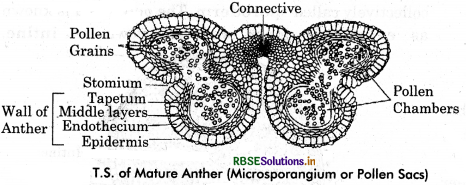
Sporogenous Tissue: The primary sporogenous cell undergo several mitotic divisions to form microspore mother cells. A massive mass of sporogenous cells inside anther walls, called sporoginous tissue. Many cells of this tissue undergo meiosis to form microspores.
Question 14.
What is pollinium? Explain.
Answer:
Compound Pollen Grains and Pollinium:
In the members of the cyperaceae family, pollen mother cell divides meiotically to form four nuclei. However, three of these degenerate. The remaining nucleus forms the only microspore. Thus, in the members of this family only one microspore is formed by one pollen mother cell instead of usual four.
In Typha, Juncus, Drosera etc., all the four microspores do not seperate but together form compound pollen grains. In family mimosaceae, 8 - 64 microspores or pollen grains may remain united. In Calotropis and many orchids, all the pollen grains of a sporangium form a single mass known as pollinium. The two adjacent pollinia are connected to a sticky corpusculum to form a translator.
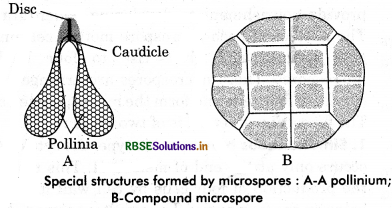
Question 15.
(a) Draw a well - labelled diagram of pollen grains.
(b) Write the function of tube cell.
Answer:
(a)
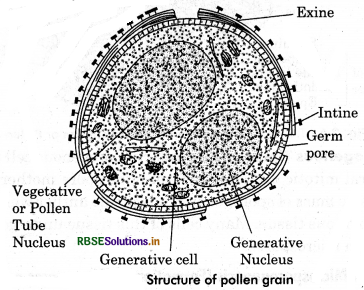
(b) A tubular structure which is produced by the male gametophyte of seed plants when it germinates is known as a pollen tube. An integral stage in the plant life cycle is the pollen tube elongation. This tube acts as a conduit for transportation of the male gamete cells from the pollen grain which is either from the stigma to the ovules at the base of the pistil or directly through the ovule tissue in some of the gymnosperms.
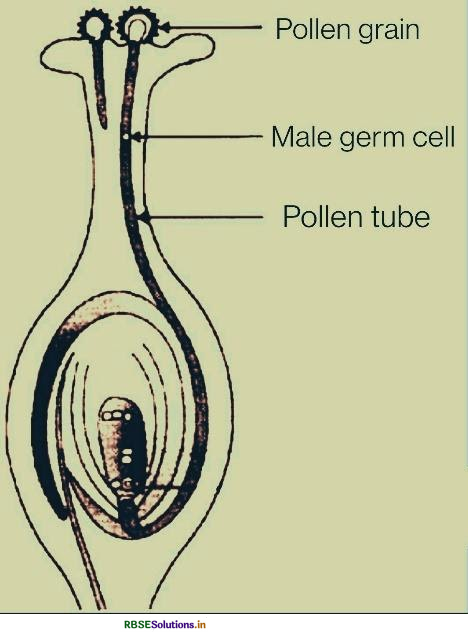
Pollen tubes are unique to plants and the structure of these tubes have evolved over time throughout the history of plants. For sexual reproduction to occur in seed plants, the formation of pollen tubes is important. Pollen grains are transported to the female gametophyte by the help of wind, water or pollinators. Carrying of male gametes towards ovary through stigma and style is the main function of pollen tube. It enters the ovule by the micropylar end and then to the synergid cell which is present next to the egg cell. The entry of the pollen tube into synergids is guided by the filiform apparatus.
When a pollen grain gets implanted on a compatible stigma with the help of self - incompatibility mechanisms, the germination process gets initiated. At this process, a conformational change is undergone by the pollen grain, whereupon a given section of it begins to protrude outwards which form a tube - like structure, known as the pollen tube.

Question 16.
What is pistil? Name Its part. Draw labelled diagram of a pistil.
Answer:
Gynoecium or Pistil (Megasporophyll):
Gynoecium represents female reproductive part of the flower, also called pistil. The gynoecium may consists of a single carpel (Monocorpellary), two carpels (Bicarpellary), three carpels (Tricarpellary) or many carpels (Multicarpellary). The carpel is a modified leaf earing ovules along the margins, hence it is also called megasporophyll. When the carpels are free as in Michelia and Ranunculus, the gynoecium is called apocarpous and if carpels are fused as in poppy (Papayer) and gurhal (Hibiscus), the gynoecium is called syncarpous.
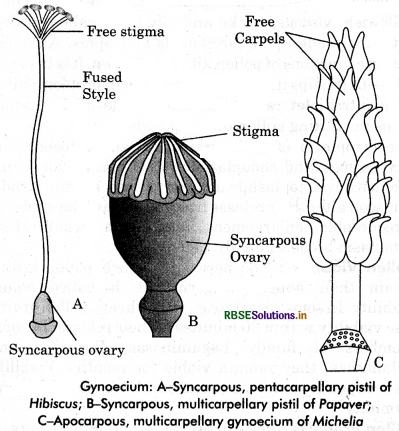
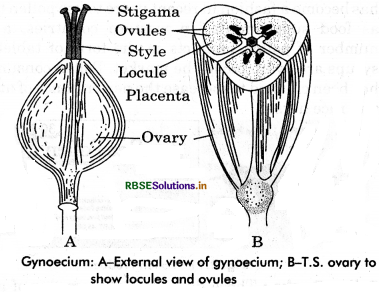
Each pistil has three parts : (i) ovary, (ii) style and (iii) stigma. The basal swollen part of pistil is called ovary. It bears ovules. There are usually as many locules in a polycarpellary pistil as there are carpels. The number of ovules in an ovary may be one (wheat, paddy, mango) to many (watermelon, papaya, orchids). A tube like structure found at the apex of ovary is called style. Style, bears stigma at its top and gives passage to pollen tube. Stigma is the upper part of carpel. Pollen grains are received during pollination by stigma.
Question 17.
Write down the names of post fertilization events in flowering plants. Describe the process of embryo development.
Answer:
Post fertilization events in flowering plants:
Post - fertilizaation events refers to all the evemts of sexual reproduction taking place after fertilization. that is, after the formation of zygote.
The major event taking place in this stage is embryo - genesis, i.e., development of the embryo.
Post fertilization basically involves:
- Early embryonic development.
- Establishing multi - cellularity,
- Formation of blastula.
- Formation or embryonic germ layer.
Embryo development:
The embryo is the part of a seed that contains the earliest forms of a plant roots, stem and leaves i.e., redicle, plumule and cotyledons respectively. , Embryo develops from zygote after fertilization and this prbcess is called embryogenesis. There is no fundamental difference in the early stages of 4evelopment in dicotyledonous and monocotyledonous embryo development. Zygote of both dicot and monocot form proembryo by dividing transversely. Its micropylar end cell is called basal cell and cell of chalazal end is called terminal cell.
A. Development of Dicot Embryo:
First of all Hanstein (1870) studied the embryo development in Capsella bursa pastoris, a member of family Brassicaceae. It is also called onagrad type of an embryo. First of all, zygote enlarges in size and divides transversely to give rise to two cells i.e., terminal cell towards chalazal end and basal cell toward micropylar end. The basal cell near the micropylar end of embryosac, grows in size and called suspensor cell. The suspensor cell divides transversely to form a row or seven to eight cells, called suspensor.
The suspensor pushes the developing embryo deep into the developing endosperm. The first cell of the suspensor towards the micropylar end becomes swollen and form houstorial cell i.e., haustorium. It absorb food materials for the developing embryo. The last cell of suspensor adjacent to the embryo is known as hypophysis. It gives rise to the redicle and root cap.
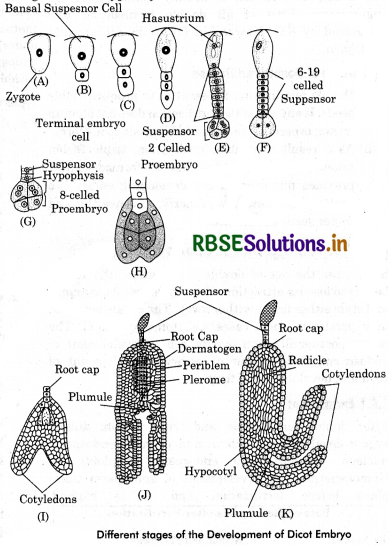
B. Development of Monocot Embryo:
The early stages of embryo development are very similar in both monocot and dicot plants. The main differences in the mature embryos of monocot and dicot are due to the number of cotyledons and position of plumule. The zygote elongates and then divides by a transverse wall into a basal cell and a terminal cell. The basal cell lies towards micropylar end, produces a large swollen vesicular suspensor cell, it may serve as haustorium. The terminal cell divides by another transverse wall to form two cells. The top cell, after repeated divisions forms the plumule and a single cotyledon.
The cotyledon called scutellum, grows rapidly and pushes the terminal plumule to one side. The plumule comes to lie in a depression. The middle cell, after many divisions, forms the hypocotyl and radicle. A few cells are also attached to the suspensor. In some plants (such as cereals), both plumule and radicle get surrounded by sheaths developed from scutellum called coleoptile and coleorhiza respectively.
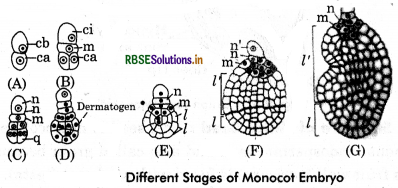
Question 18.
What is endosperm? Explain various types of endosperms.
Answer:
After double fertilization and triple fusion, diploid zygote develops into embryo and primary endosperm nucleus develops into endosperm (triploid). In Gymnosperms, the development of endosperm takes place before fertilization and it is haploid.
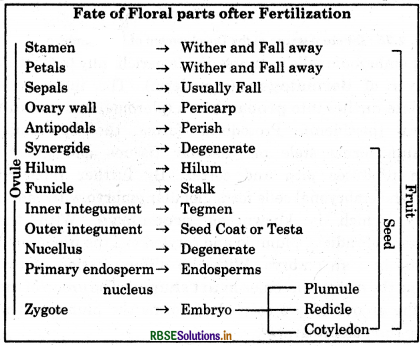
Endosperm is a highly nutritive tissue which provides nurishment to the developing embryo. In plants like peas, beans etc., the entire endosperm is consumed for the nutrition of the developing embryo, thus the mature seeds are without endosperm and such seeds are known as non-endospermic and they store food in the cotyledons. On the other hand, even the mature seeds of coconut, cereals, castor etc., retain endosperm and such seeds are endospermic. The endosperm present in the seed is used in the establishment of the young seedling.
Types of Endosperm on the basis of development, the endosperm is of following three types:
1. Nuclear endosperm
2. Cellular endosperm
3. Helobial endosperm
Importance of Endosperm: The main function of endosperm is to provide nourishment during the early stages of embryo development. Endosperm provides food for seedling during seed germination. In artificial embryo culture experiments, the milk of coconut, which is a liquid endosperm, is used in embryo culture of many species. Such type of characters are also seen in the juice of primary endosperm of maize and walnut.
Long Answer Type Questions
Question 1.
Describe the process of mega sporogenesis up to fully developed embryo sac formation in an angiosperm.
Or
Where does the process of megasporogenesis start in an angiosperm? Describe the process up to the formation of embryo.
Or
Explain in detail the process of development of female gametophyte. Draw diagram.
Answer:
Development of Embryo Sac (Female Gametophyte):
Based on the number of megaspore mother cells contributing to the development of embryo sac, the embryo sacs are of three types:
- Monosporic (Developed from one functional megaspore),
- Bisporlc (Developed from one dyad or a cell formed from first meiotic division).
- Tetraspork (Developed from all the four cells formed after complete meiosis).
The most common type of embryo sac development îs monosporic or polygonum type. In this the haploid nucleus of functional megaspore divides mitotically to form two nuclei which move to the opposite poles forming a two - nucleate embryo sac. Two more mitotic nuclear divisions result in the formation of a nuclei in the embryo sac. After 8 - nucleate stage, the cell walls are formed leading to the formation of a typical female gametophyte or embryo sac. It enlarges in size due to the formation of a central vacuole.
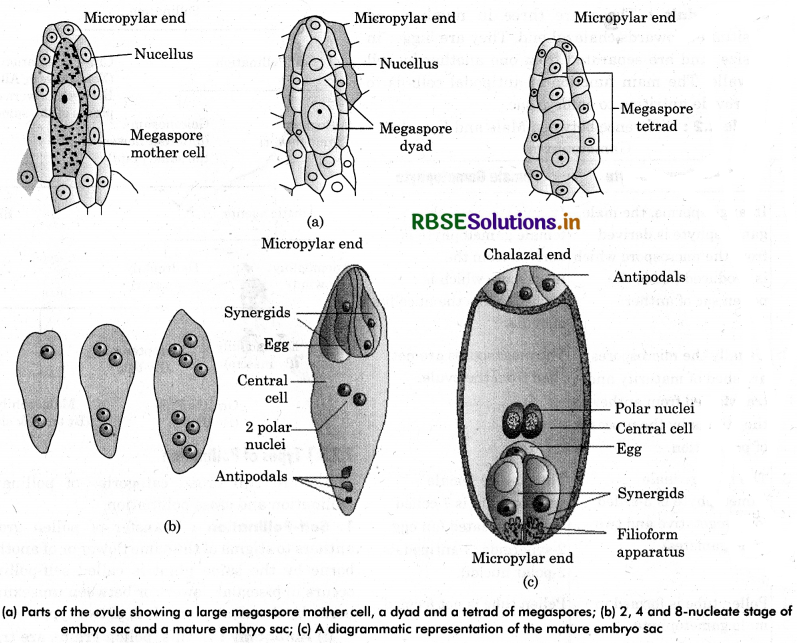
Question 2.
(i) Describe any two devices in a flowering plant which prevent both autogamy and geitonogamy.
(ii) Explain the events up to double fertilization after the pollen tube enters one of the synergids in an ovule of an angiosperm.
Answer:
(i) Autogamy: In this, pollen grains are transferred from anther to stigma of the same flower. It always occurs in bisexual flowers. For autogamy, it is essential that both anther and stigma mature at the same time. Examples : Rice, wheat, pea etc.
Geitonogamy: In this pollen grains of one flower are transferred to the stigma of another flower borne on the same plant. Since male and famel reproductive parts belong to the same parent plant, both autogamy and geitonogamy represent sell pollination.
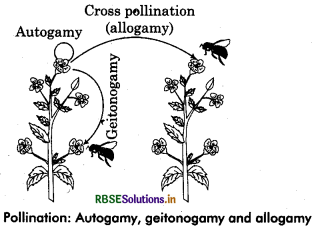
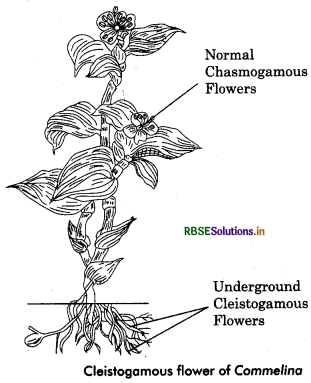
(ii)After penetration into embryosac, the pollen tube bursts to release both the male gametes. Of these, only one of the two nuclei of male gametes fuses with the nucleus of egg cell to form diploid (2n) zygote. It is the first fertilization. This process is called true fertilization or syngamy. The diploid zygote develops into embryo. The nucleus of second male gamete fuses with two polar nuclei of the certral cell or secondary nucleus (2n). Secondary nucleus has already two nuclei and after the fusion with male nucleus, the number of nuclei becomes three in it. Since, this process involves fusion of three nuclei, it is called triple fusion and the nucleus so formed is called primary endosperm nucleus. It develops into endosperm.
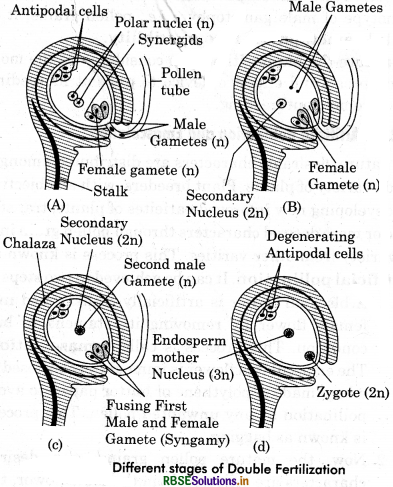
Thus, both the male gametes are involved in the act of fertilization i.e., fertilization takes place twice, that is why, it is called double fertilization. Thug, double fertilization involves both true fertilization and triple fusion. The double fertilization is usually found in all the
angiosperms. First of all double fertilization was discovered by S.G. Nawaschin (1898) in Lillium and Fritillaria.
Significance of Double Fertilization:
- Double fertilization is essential to produce viable seeds. if any one of the fertilization does not occur in an angiosperiniic plant, the viable seeds do not form.
- As a result of double fertilization, triple fusion takes place and endosperm is formed, which provides nutrition to the developing embryo so that embryo develops properly, and healthy and better seeds are formed.

Question 3.
(i) Explain any two ways by which apomictic seed can develop.
(ii) List one advantage and one disadvantage of an apomictic crop.
(iii) Why do farmer find production of hybrid seeds costly?
Answer:
(i) Apomictic seeds can develop in two ways as follows:
- These are produced from segmenta of fruit (mango stem), male gametic content of pollen (Cyperus) and other vegetative parts.
- In some species, the diploid egg cell is formed without reduction division and develops into embryo without fertilization.
(ii) Advantage of Apomictic Crop: These are the products of asexual reproduction in the absence of pollinators and takes place in extreme environment.
Dbadvantage of Apomictic Crop: During the production of apomictic crop there is no segregation of characters in the hybrid progeny.
(iii) Apomixis produces hybrid seeds and it is a costly process. Since, hybrid seeds do not maintain hybrid characters, the apomictic seeds are to be produced year after year. This is the reason why farmers find production of hybrid seeds costly.
Question 4.
(i) When a seed of an orange is squeezed, many embryos instead of one are observed. Explain, how it is possible?
(ii) Are these embryos genetically similar or different? Comment.
Answer:
(i) It is true that when we squeeze a seed of an orange, many embryos, instead of one are observed. It takes place due to a process called polyembryony. It is the phenomenon of occurrence of more than one embryo in a seed. It was first observed by A.V. Leeuwenhock in 1719 in Citrus. Polyembryony can be spontaneous or induced experimentally. The polyembryony may arise by the following reasons. Formation of additional embryos from synergids or from antipodal cells and polar nuclei. Some embryo can also be derived by the activation of some sporophytic cells of ovule such as nucellus or integument. Embryo can also be developed from an additional embryo sac in the same ovule.
(ii) The embryos formed as a result of polyembryexy are genetically similar to one another. However, the embryos arising from gametophytic tissues are similar to each other, but not to their parents. The embryos that are derived from sporophytic tissues are usually similar to each other as well as their parents.
Question 5.
What is microsporophyll? Describe the development of microsporangium with diagram.
Answer:
Stamen (Microsporophyll):
The stamen or microsporophyll is known as the male reproductive part of the flower. They are attached either to the thalamus or to the petals. The number, length and arrangement of stamens vary in flowers of different species. Each stamen has following three parts:
1. Filament: It is cylindrical, massive or thread - like stalk of the stamen. It supports anther terminally and is attached to the thalamus by its basal end. It also suplies water and nutrients to anther.
2. Anther: It is the swollen structure at the terminal end of a filament. Usually anthers are bibbed and contain four microsporangia (pollen sacs). Such anthers are called dithecous. But in some plants e.g., Hibiscus, they have one lobe and two microsporangia. They are called monothecous.
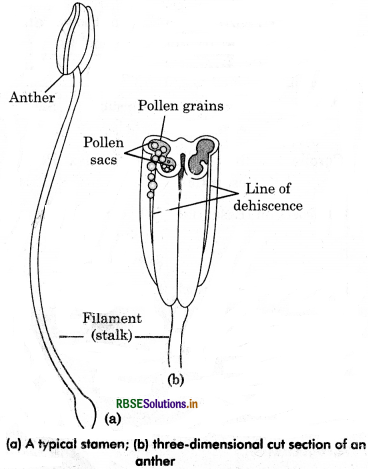
Anthers are not fully formed in some stamens, such stamens are cafled staminodeg, (e.g., Amaltas). Number of stamens is equal to the number of petals or double the number of petals in flowers. In some flowers stamens are sterile, e.g., Nymphaea.
3. Connective: It is the extension of a filament between two anther lobes to join them together.
Development of Microsporangium:
A very young anther has a homogenous mass of a group of actively dividing parenchymatous cells, which is surrounded by single layer of epidermis. Below the epidermis, some cells contain a prominent nucleus and dense cytoplasm. These cells are called archesporial cells or archesporial initials. Furthermore, the young anther soon becomes two lobed. Each anther lobe develops into two microsporangia in its two corners as a rounded mass of archegonial cells.
Thus, one archesporial cell is developed at each corner. The four microsporangia of an anther finally develop into four pollen sacs. Each archesporial cell divide periclinally to form an outer cell called primary parietal cell and inner primary sporogenous cell. The parietal cell divide by periclinal and anticlinal divisions and forms 2 - 5 layered anther wall. The primary sporogenous cell directly functions as microspore mother cell or it may divide by mitotic divisions and then functions as microspore mother cells.
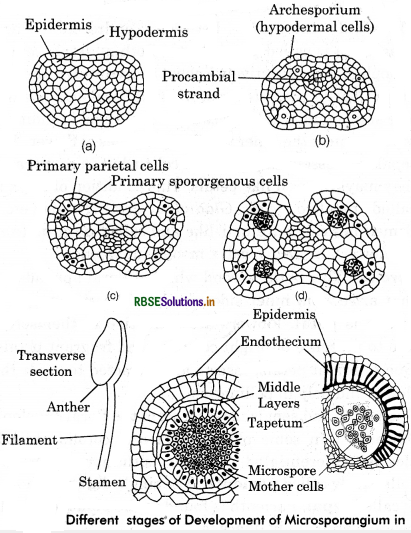
Question 6.
Describe the structure of mature microsparongium with diagram.
Or
Explain the structure of microsporangium and write the functions of its different layers. Draw diagram of microsporangium showing wall layers.
Answer:
Structure of Microsporangium (or Pollen sac):
In a transverse section a typical microsporangium appears circular in outline. It has mainly two parts- anther wall and pollen chamber.
1. Epidermis: It is the outermost layer. It is only one cell in thickness.
2. Endothecium : It is situated below the epidermis. Mostly there is a single layer of endothecium, but sometimes it is two layered. The cells of endothecium are tangentially elongated and attain their maximum development when pollen grains mature. The radial and inner tangential walls of these cells have characteristics fibrous thickening bonds. Due to these bonds, the endothecium cells are hygroscopic in nature, hence, play an important role in the dehiscence of anthers.
3. MIddle layer.: It lies inside the endothecium and made-up of 1.3 layers of thin-walled cells. The cells of these layers survive for short-time. The middle layer may store food material in some species which is utilized by pollen mother cells.
4. Tapetum : This is the innermost layer of cells with dense cytoplasm. Tapetum nourishes the developing pollen grains and secrete both enzymes and hormones, it contains two types of cells:
- Amoeboid or Periplasmodial cells grow and form a periplasmodium that provides nourishment and other material to spore mother cells, e.g., Lily, Typha, Tradescantia, Alisma etc.
- Secretory or Glandular cells secrete nourishment that passes into sporogenous cells, e.g., Symphoricapus. Uhimately, both the types of tapetum degenerate.
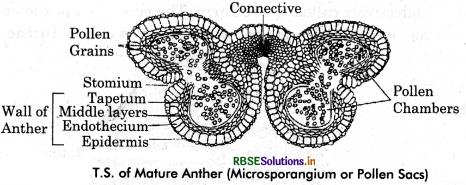
Sporogenous Tissue : The primary sporogenous cell undergoseveral mitotic divisions to form microspore mother cells. A massive mass of sporogenous cells inside anther walls, called sporoginous tissue. Many cells of this tissue undergo meiosis to form microspores.
Question 7.
Write a note of Dehiscence of anther.
Answer:
Tapetum and middle layers of mature anther aredigested by the developing pollei grains and only epidermis towards outside and endothecium towards inner side are left. The water is evaporated from the cells of endothecium so that thin outer wall of these cells is shrunk towards inner side, as a result of this, a pressure is exerted in the stomium cells and they burst. The strip between the two pollen sacs of each anther lobe also disintigrates to form a single cavity. The dehiscence of anther takes place by four different methods:
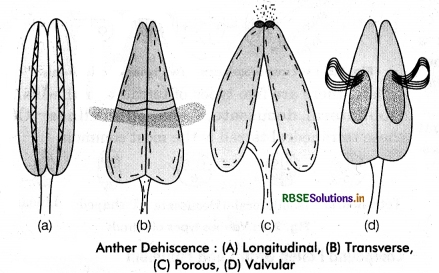
(i) Transverse dehiscence : In this type, anther lobes dehisce transversally or dehisce in width. e.g., Ocimum sanctum.
(ii) Longitudinal dehiscence : In this type, the anther lobes dehisce longitudinally or dehisce along the length of anther e.g., Gossypium, Datura, Hibiscus etc.
(iii) Porous dehlscence : This type of dehiscence takes . place by one or two terminal pores, e.g., Solanum nigrum.
(iv) Valvular dehlscence : Such type of dehiscence takes place by one or many valves, which is like a shutter of a window and opens only outside, e.g., Berberis etc.
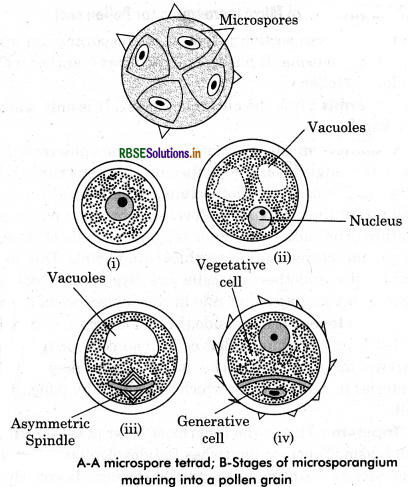
Question 8.
What is male gametophyte. Write short note on microgametogenesis.
Answer:
MaIe Gametophyte (Microgainetogenesis):
1. Pre - pollination Development : Development of male gametophyte starts in pollen grain while still present inside the microsporongium or pollen sac. The nucleus of pollen grain grows in size, moves to a side near the wall and divides mitoticafly to form a large vegetative nucleus and a small generative nucleus. A wall is formed between the two nuclei, thus a large vegetative cell and a small generative cell are formed. A layer of callose develops around the generative cell. Later on, the callose dissolves and the naked generative cell comes to lie freely in the cytoplasm of the vegetative cell. At this stage, pollengrains liberate from pollen sacs and reach stigma.
(i) Vegetative Cell : The nucleus of vegetative cell is spherical or irregular is shape. The cytoplasm of the vegetative cell contains, ribosomes, rough endoplasmic reticulum, mitochondria, dictyosomes, plastids and starch grains. This cell normally does not divide, although it is capable to DNA synthesis.
(ii) Generative Cell : The wall of generative cell is acurate in outline, but looks quite irregular. Its texture is relatively uniform and may show occasional small electron opaque structures. There is no cytoplasmic connection between the generative cell and vegetative cell. The dense cytoplasm of generative cell contain mitochondria with conspicuous internal organelles. The nucleus of the generative cell occupies most of the cell volume.
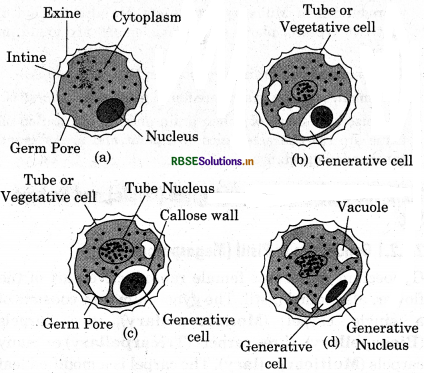
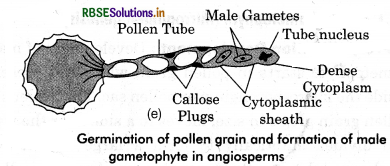
In majority of plants, pollen grains are liberated at 2-cell stage. In some species, the generative cell divides mitotically to give rise to two male gametes before the pollen grains are released (3-cell stage). Thus, at the time of pollination, the pollen grains are either 2-celled (tube cell + generative cell) or 3-celled (tube cell + two male gametes).
2. Post - Polilnation Development : On reaching the stigma, pdllen grain absorbs water and nutrients from the stigmatic secretion through its germ pores. Due to this vegetative cell enlarges and comes out of the pollen grain through one of the germ pores and forms a pollen tube. The pollen tube is covered by intine. When the style is solid, the pollen tube secretes pectinases and other hydrolytic enzymes to create passage.
The vegetative nucleus, descends to the tip of the pollen tube along with the generative cell. The vegetative nucleus is now called tube nucleus. The generative nucleus soon divides mitotically into two male gametes if had not already divided. Each male gamete has a large nucleus surrounded by a thin sheath of cytoplasm, externa1ly limited by a cell membrane. In most of the angiosperms the cell membrane is not covered by cell wall, hence the male gametes are naked.
Question 9.
Describe the types of ovule.
Answer:
Types of Ovule:
On the basis of relationship between position of funiculus, micropyle and chalaza, the ovules of angiosperms are classified into following types:
1. Orthotropous : This is the most primitive type of ovule. This ovule is straight and devoid of any curvature, therefore, funicle, chalaza and micropyle all lies in one straight line. This type of ovules are found in the members of polygonaceae family. e.g., Rumex, Polygonum and the family piperaceae e.g., Piper betal, Piper nigrum etc.
2. Anatropous : This is the most common type of ovule. In it, the body of an ovule is inverted and micropyle lies close to hilum. The funicle is curved at the apex and fuses with the integuments forming raphe. The micropyle and chalaza lie in one verticle line. This type of ovule found in 82% of families e.g., Pea, Gram, Castor etc.
3. Amphitropous or Transverse : In this type of ovule, the body of ovule shows curvature and almost becomes horse. shoe-shaped. The embryosac also show the same curvature. The fumcle is attached near the middle of the body. The micropyle, chalaza and hilum come very close to each other. e.g., Capsella etc.
4. Campylotropous : In this type, body of ovule becomes curved so that the micropyle and chalaza come to lie on either side of the funicle, the micropyle is directed towards the base of funicle because the curvature of the nuceflus. The funicle is attached near the middle of the body of ovule. The raphe is not formed. The embryo sac is more or less straight. This type of ovule is found in the members of family Brassicaceae and Capparaceae.
5. Hemitropous : In this type. the body of ovule is twisted only half way so that the degree of curvature is intermediate between orthotropous and anatropous, i.e., at right angle to the funicle. The micropyle - chalaza line is horizontal and placed at 90° to the line of funicle. The embryosac is straight but horizontal with its egg apparatus facing towards micropyle. e.g., in the members of family Ranunculaceae and Primulaceae.
6. Circinotropous : In this type, the ovule is straight with micropyle facing upwards. The funicle is long and appears as coiled structure. It completely encircles the ovule. Initially the ovule is orthotropous but during its course of development it rotates to 360° and again gets straight due to unilateral growth of funicle. This type of ovule is found in family Plumbaginaceae, Cactaceae etc.
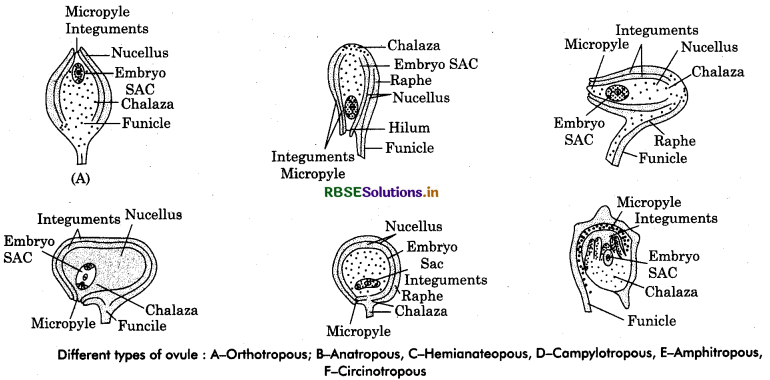
Question 10.
Write a detail note one megasporogenesis with diagram.
Answer:
Megasporogenesis (Formation of Megaspore):
The process of formation of megaspores from the megaspore mother cell is known as megasporogenesis. It takes place inside the nucellus of developing ovule. In initial stage any one sub epidermal cell of nucellus of the micropylar region becomes large having big nucleus arid dense cytoplasm. This cell is called archesporial initial.
This archesporial cell may directly function as megaspore mother cell or divide periclinally to form an outer parietal cell and an inner sporogenous cell. The sporogenous cell behaves as megaspore mother cell. It undergoes meiosis or reduction division by which a linear row of four haploid megaspore cells is formed. Meanwhile, two integuments develop from the base of ovule, In majority of flowering plants, only the chalazal megaspore remains functional while the other three degenerate.
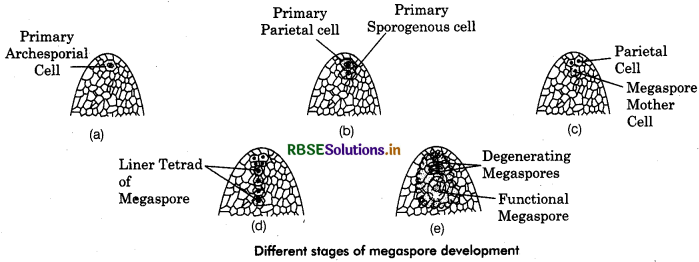
Development of Embryo Sac (Female Gametophyte)
Based on the number of megaspore mother cells contributing to the development of embryo sac, the embryo sacs are of three types: .
1. Monosporic (Developed from one functional megaspore).
2. Blsporic (Developed from one dyad or a cell formed from first meiotic division).
3. Tetrasporlc (Developed from all the four cells formed after complete meiosis).
The most common type of embryo sac development is monosporic or polygonum type. In this the haploid nucleus of functional mega spore divides mitotically to form two nuclei which move to the opposite poles forming a two-nucleate embryo sac. Two more mitotic nuclear thvisions result in the formation of 8 nuclei in the embryo sac. After 8-nucleate stage, the cell walls are formed leading to the formation of a typical female gametophyte or embryo sac. It enlarges in size due to the formation of a central vacuole.
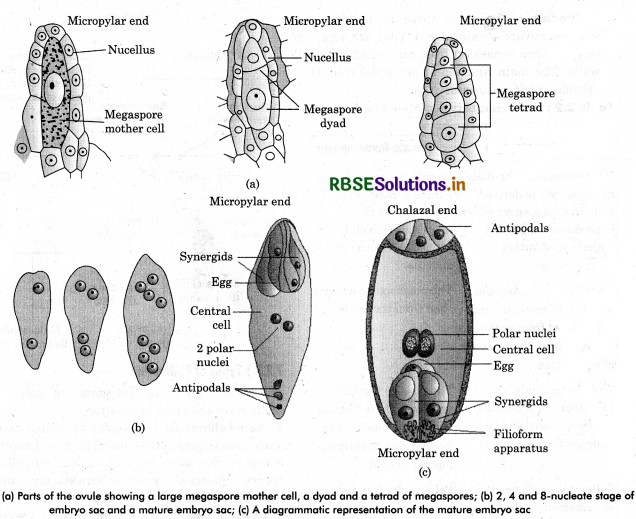
The fully developed female gametophyte or embryo sac is an oval and multicellular haploid structure. It is embedded in the nucellus towards micropylar half of the ovule. Embryo sac contains 8-nuclei. Of these, four nuclei lie at micropylar end and the other four of chalazal end. 1’hree nuclei at the micropylar end form egg apparatus, and the fourth one migrates to the centre and forms one of the two polar nuclei. At chalazal end, the three nuclei form antipodal cells and the fourth nucleus migrates to the centre to form the second polar nucleus. Thus, embryo sac is a 7-celled structure with 8 nuclei.

Question 11.
Draw the structure of fully developed embryo sac and comment.
Answer:
Development of Embryo Sac (Female Gametophyte)
Based on the number of megaspore mother cells contributing to the development of embryo sac, the embryo sacs are of three types: .
1. Monosporic (Developed from one functional megaspore).
2. Blsporic (Developed from one dyad or a cell formed from first meiotic division).
3. Tetrasporlc (Developed from all the four cells formed after complete meiosis).
The most common type of embryo sac development is monosporic or polygonum type. In this the haploid nucleus of functional mega spore divides mitotically to form two nuclei which move to the opposite poles forming a two-nucleate embryo sac. Two more mitotic nuclear thvisions result in the formation of 8 nuclei in the embryo sac. After 8-nucleate stage, the cell walls are formed leading to the formation of a typical female gametophyte or embryo sac. It enlarges in size due to the formation of a central vacuole.

The fully developed female gametophyte or embryo sac is an oval and multicellular haploid structure. It is embedded in the nucellus towards micropylar half of the ovule. Embryo sac contains 8 - nuclei. Of these, four nuclei lie at micropylar end and the other four of chalazal end. 1’hree nuclei at the micropylar end form egg apparatus, and the fourth one migrates to the centre and forms one of the two polar nuclei. At chalazal end, the three nuclei form antipodal cells and the fourth nucleus migrates to the centre to form the second polar nucleus. Thus, embryo sac is a 7- celled structure with 8 nuclei.
Question 12.
Write the adaptations in flowers which are pollinated by external agencies.
Or
Describe the contrivances for cross pollination.
Answer:
2. Cross Pollination (Xenogamy or Allogamy) : Transfer of pollen grains form the anther of one flower to the stigma of another flower borne on a different plant, is called cross.pollination or Xenogamy. The term allogamy includes both geitonogamy and xenogamy. Cross-pollination can occur in both dioecious and monoecious species, but dioecious species are necessarily cross pollinated. Cross pollination is performed with the help of an external agencies such as wind, water, insects, birds, bats etc.
Contrivances or Adaptations for Cross - Pollination:
Flowers show a number of adaptations which induce cross - pollination where self-pollination might otherwise be possible. Some of these adaptations are as follows:
(i) Self-Sterility or Self-IncompatIbility : In some bisexual flowers, pollen grains of one flower fail to grow on the stigma of the same flower. It prevents self-fertilization. It can be due to various reason. In such cases there is specific inhibition of pollen growth on the stigma. In Petunia axillaris, although pollens germinate on the stigma of same flower, the growth of pollen tube is checked down in the style. In Malva, the pollen grains do not germinate at all on the stigma of same flower.
(ii) Herkogcimy: In some bisexual flowers, where stigma and anthers mature at the same time, Beif pollination is averted by some physical barrier. This condition is called herkogamy. Some examples of physical barrier which check self pollination are -
(a) Extrose dehiscence of anthers that pollen does not fall on the stigma.
(b) In Calotropis and orchids pollinia enclose pollen grams and can be transferred by insects only.
(c) In Salvia, a lever mechanism operates to shed pollen grains at the back of insect visiting flower far nectar.
(d) In Gloriosa, anthers dehisce at a distance so that the stigma is out of reach of its own pollen.
(iii) Dichogamy: In some bisexual flowers, anthers and stigma are mature at different times. This is called dichogamy. It maybe two types:
(a) Protandry : The anthers mature earlier so that its stigma is not ready to receive pollen from its anthers. e.g., Salvia, Sunflower, Gossypium, .Saxifraga etc.
(b) Protogyny: Stigma mature earlier so that they get pollinated, before the anthers of the same flower mature and develop pollen grains. e.g., Mira bilis, Plantago, Gloriosa etc.
(iv) Heterostyly : The flowers of some plants have different lengths of stamens and styles so that self pollination is not possible. There are two types of these flowers:
(i) Short styled flowers : They bear stigma of about half the height of corolla tube, thus standing well below the anthers and the stamens are long and the pollen grains are spherical and larger. e.g., Primula vulgaris.
(ii) Long styled Flowers: Which posses a long style standing high above the anthers and small stamens with smaller and oblong pollen grain.
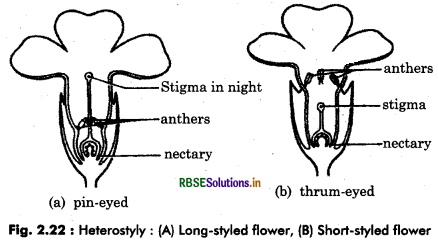
Question 13.
Differentiate between self pollination and cross pollination.
Answer:
|
Self-Pollination |
Cross-Pollination |
|
1. Pollen grains are transferred from anther to stigma of the same flower or another flower borne on the same plant. |
1. Pollen grains are transferred from anther of one flower to stigma at another flower borne on a different plant of same species. |
|
2. Bisexual flowers or monoecious conditions are required for self - pollination. |
2. For cross-pollination, bisexual flowers or hermaphrodite plants may not be required. |
|
3. Both anthers and stigma mature at the same time. |
3. The anthers and stigmaof a flower mature atdifferent time. |
|
4. For seif-pollifiation, coloured, bright, large and attractie flowers are not necessary. |
4. For cross-pollinationcoloured, bright, largeand attractive flowersare necessary. |
|
5. External agents are not require for self pollination. |
5. For cross-pollination, external agents are required. |
|
6. It is economical for the plants. |
6. It is not economical as the plant has to produce a large number of pollen grains, nectar, scent and bright coloured corolla etc. |
|
7. Self pollination results in prôgenies which are pure line i.e., homozygous. |
7. Cross pollination resultsin hybrids, i.e.,heterozygous. They showvariations in characteristics. |
Question 14.
Write short notes on the following:
(a) Anemophily
(b) Entomophily
(c) Hydrophily
(d) Chiropterophily
Answer:
(a) Anemophily:
The pollination of flowers by wind is called anemophily. The flowers which are wind pollinated are known as anemophilous. The anemophilous flowers are characterised by the following adaptations:
- Flowers are small, colourless, odourless and nectarless and inconspicuous.
- In such flowers, calyx and carolla are either reduced or absent. Anthers are usually versatile and exerted.
- Pollen grains of these flowers are small, light, dry and dusty and sometimes winged, so that they are easily blown by wind over long distance, upto 1300 km.
- Pollen grains are produced in large quantity. For example, a single flower of Cannabis produces 5,00,000 pollens and million by a tassel of Zea mays.
- The stigmas are usually branched, broad, large, well-exposed and hairy to catch pollens from the air.
- When flowers unisexual, the staminate flowers are much more numerous then the pistilate flowers. In bisexual flowers the stamens are generally numerous.
- In plants like Urtica burst suddenly to throw pollen grains into the air called gunpowder mechanism.
- In certain cases, flowers are produced before the appearance of leaves to increase chances of pollen grains reaching the stigma.
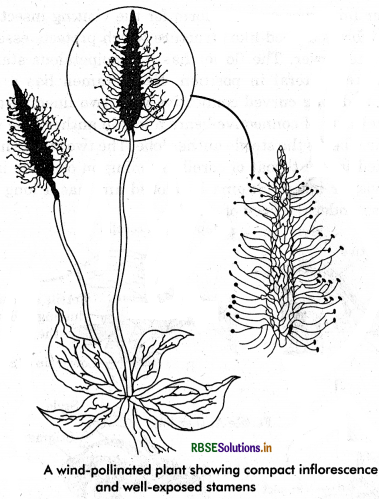
(b) Entomophily:
When pollination is brought about by the agency of insects, it is called insect pollination or entomophily. The most common insect pollinators are : moth, bees, wasps, flies, honeybees, butterflies, beetles etc. Insects visit flowers for nector, ethble pollens or shelter. Honeybees have pollen baskets for collecting pollens. The entomophilous flowers are characterised by the following adaptations:
- Flowers are usually large, conspicuous and brightly coloured to attract insects. Sometimes when flowers themselves are not conspicuous, other part- may become coloured and’ showy to attract the insects e.g., bracts in Bougainvillea, calyx of Mussanda and Larkspur.
- Small flowers bloom in bunches t,o attract the insects. Sometimes they are condensed together to form a head (e.g., sunflower). Under such condition a single insect pollinates a large number of flowers.
- Sorne flowers secrete nector, which is food of insects. Insects reach to such flowers in the search of food, and finally help in pollination.
- In many cases, special markings occur on petals for guiding the insects to nectar glands. These are called honey or nector guides as in Viola.
- Most of the nocturnal flowers are insect - pollinating. They give out a sweet smell of night to attract insects from a distance.
- The sepals and petals are well developed, showy and attractive. Sometimes petals develop peculiar shaps to attract insects.
- Pollen grains covered with a yellowish, sticky substance called pollenkitt. This makes pollen grains stick to the body of insect.
- The stigma is also sticky to çatch pollen grains easily.
- The insect-pollinated flowers usually blossom at a time when the particular insect is also active.
- Some flowers provide a platform for the landing insects and safe place to laying egg, e.g., Yucca, Amarphophallus.
- Pollinia of Calotropis and related plants can not be’ transferred to the stigmatic surface without the help of insects.
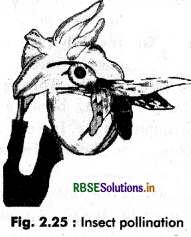
(c) Hydrophily:
The transfer of pollen grains from anther to stigma by means of water is called hydrophily. All aquatic plants are not hydrophilous. For example, aquatic plants, Alisma and Nymphaea are entomophilous plants, while Potamogeton and Myriophyllum are anemophilous. Characteristics of hydrophilous flowers are:
- They are small and inconspicuous.
- They are nectarless, colourless and odourless.
- Univettable perianth, other floral parts and pollen graine.
- The pollen grains of these flowers are light but covered with wax.
- Long and sticky stigma.
Examples of Hydrophily: Vallisneria, Hydrilla, Zostera, Ceratophyllum etc.
Hydrophily is of two types:
(a) Hypohydrophily : It occurs in totally submerged plants such in Zostera, Ceratophyllum etc.
(b) Epihydrophily : It occurs in those aquatic plants where flowers remain at the surface of water as in Vallisneria.
In vallisneria, the plants are dioecious, i.e., the male flowers are small, short-stalked and produced in large numbers. These flowers are urrounded by a spath under water. The female flowers, on the other hand, are solitary are borne on long and coiled stalks. On maturing, male flowers get detached from plant and float on the surface of water owing to the opening of the perianth into a boat-like structure.
At the same time, female flower rises to the water surface by the straightening of stalk. As the male and female come in contact, male flower is drawn in the depression of female flower and anthers come in contact with the large trifid stigma of female flower. They burst liberating pollen grains which stick to the stigma. After pollination, the female flower and close and their long stalks curl up, drawing the flowers below the surface of water down in the mud where the seeds and fruits developed.
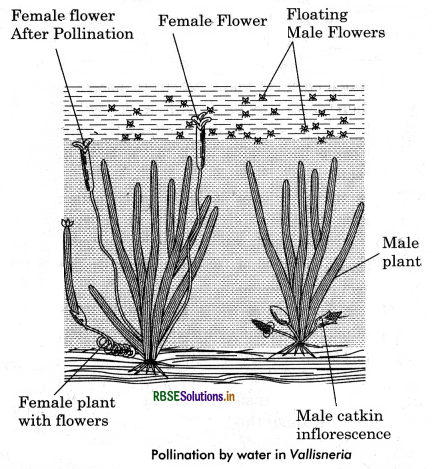
(d) Chiropterophily
•ADOPTIONS;
1. Flower is large, stout.
2. Plants arc nocturnal.
3. Large no of pollen grain are produced.
4. Example: Anthocephallus, Kigella pinnata.

Question 15.
Write short notes on the following:
(a) Pollination in Salvia.
(b) Pollination in Ficus.
Answer:
(a) Pollination In Salvia : In Salvia pollination is brought about by insect. In Salvia, corolla is tubular at below but its upper part is bilabiate. The lower lip serves as a platform for the visiting insect. The upper lip forms a hood - like structure which protects essential parts of the flower. The flower has two epipetalous stamens located anteriolateral in position. Each stamen has a short filament and long curved connective with two unequal arms. The longer arm of connective bears a fertile anther lobe while shorter arm bears the sterile anther lobe. The two sterile halves are located in the throat of corolla forming on obstacle in the path of visitor insect. Stigma is bibbed and has a long style lying close under the hood of corolla.
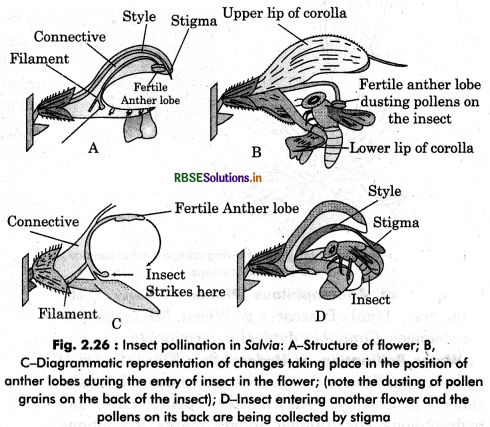
In salvia, protandrous condition is found i.e., anthers mature first. When a bee sits on the lower lip and pushes its proboscis down into the corolla tube to collect honey, the lower ends of the connective are raised due to the lever mechanism. This causes longer arms to bend down upon the back of the insect and dust it with pollen grains. When the pollen-dusted bee visits other flowers, style bends down and touches the back of the bee and receives pollens and gets pollinated.
(b) Pollination In Ficus carlca : The flowers of Fig (Ficus carica) are present in a closed receptacle made of hypanthodium inflorescence. It has a narrow hole through which insects enters into the inflorescence. In hypanthodium, there are three types of flowers male, female and gall female flowers. Male flowers are situated near the orfice while on the lower side are thelong-styled female flowers and short-styled gall flowers, which are also famele. Fig are pollinated by wasp Blasto faga, which crawls into the closed inflorescence and lays eggs into the ovules of gall flowers. The larvae develop from eggs which feed on the ovules and form galls. After passing through the pupa stage, larvae develop into mature wasps and moves out of the Fig. In doing so they brush against the male flowers present near the hole carrying pollen grains on their bodies. These pollen-laden insects crawl in the fresh figs and inadvertently pollinate the long styled-Female flowers while laying their eggs within the ‘gall flowers’.
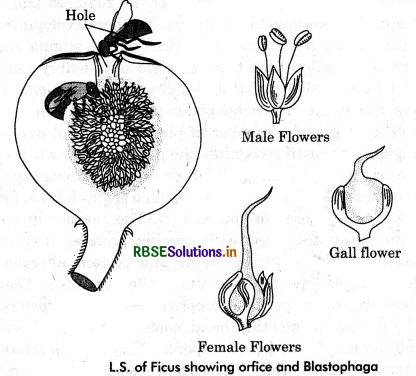
Question 16.
What do you understand by self incompatibility Explain.
Answer:
Most of the angiospermic plants have a capability to interrupt germination of pollens and further growth of pollen tube so as to avoid inbreeding and help outbreeding. This chemical control of an individual plant is called self-incompatibility. It is achieved by the interaction of chemical substances secreted by male gametophyte and tissues of style. Normally, the functional pollen grains belonging to right mating type germinate on the stigma, develop pollen tube and bring about fertilization. The pollen grams of other mating types are discarded. If a pistil carrying functional gametophyte gets pollinated with right mating type of pollen grain but fails to set seeds due to inability of their gametes to fuse with each other, thephenomenon is known as Sexual incompatibility.
It is of two types :
(i) Interspecific, between the individuals belonging to different species and
(ii) Intraspecific, between the individuals of the same species. The intraspecific incompatibility also termed as self incompatibility or se lf-sterility. The incompatibility involves many complex physiological morphological and biochemical mechanisms associated with the interaction between pollen grain and tissues of stigma. The intraspecific self- incompatibility is controlled by more than one genes. It is achieved by different processes such as:
- prevention of pollen germination
- inability of pollen tube to penetrate into the stigma
- inhibition of pollen tube growth in the style
- failure of pollen tube to enter into the ovary or ovule
- failure of the fusion of male and female gametes or
- abortion of embryo following syngamy or development of embryo-endosperm incompatibility.
The self incompatibility is of two major types:
- Heteromorphic type, in which two or more morphologically distinct mating types esent within a species which can be recognized w;nout a breeding test.
- Homomorphic type in wnich two or more mating type within a species are morphologically indistinguishable. They require proper breeding test.
Based on the factors of pollen grain, the self-incompatibility is divided into two types:
- If the incompatibility is controlled by the genotype of sporophytic tissue from which the pollen is derived or the sporophytic tissue of stigma, it is called sporophytic incompatibility.
- If it is due to genotype of male gametophyte i.e., pollen grains, it is called gametophytic incompatibility. In nature the incompatibility is considered as the most widespread and effective device to prevent inbreeding and promote outbreeding.
Question 17.
Write short notes on the following:
(a) Germination of pollen grain
(b) Entry of pollen tube into ovule.
(c) Syngamy
(d) Double Fertilization.
Answer:
(a) Germination of pollen grain
Usually two celled or sometimes three celled pollengrains land on the stigma by pollination. They swell up by absorbing water and nutrients present on the surface of stigma. Swollen tube cell grows out of the pollen grain through one of the germ pore and produces a pollen tube. Usually pollen grains are monosiphonous i.e., each pollen grain produces only one pollen tube but in some plants they are polysiphonous where more then one pollen tube are arised, only one which carries pollen nuclei grows up to the ovule and the others are degenerated. Pollen tube is surrounded by intine only.
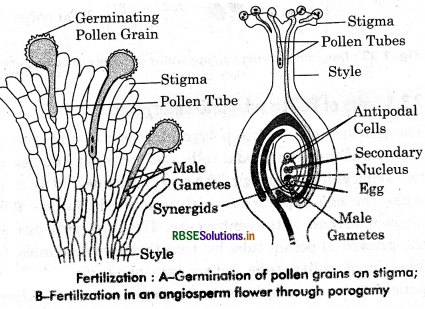
(b) Entry of pollen tube into ovule:
Pollen tube enters into the ovule through one of the following three routes:
- Porogamy: When pollen tube enters into the ovule through the micropyle, it is called porogamy. It is most common mode of pollen tube entry.
- Mesogamy : When pollen tube enters into the ovule through integuments.It is called mesogamy.
- Examples : Cucurbits, Populus, Plstacia etc.
- Chalazogamy : When pollen tube enters it the ovule through chalaza, it is called chalazogamy. e.g., Betula, Casurina, Juglans regia etc.

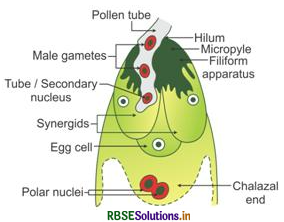
(c) Syngamy:
The most important and curious characteristic of angiosperms is the participation of both male gametes in the act of fertilization. One male gamete, out of two, fuses with the egg to form diploid zygote. This process is called syngamy or fertilization. The diploid zygote finally develops into embryo.
(d) Double Fertilization:
After penetration into embryosac, the pollen tube bursts to release both the male gametes. Of these, only one of the two nuclei of male gametes fuses with the nucleus of egg cell to form diploid (2n) zygote. It is the first fertilization. This process is called true fertilization or syngamy. The diploid zygote develops into embryo. The nucleus of second male gamete fuses with two polar nuclei of the certral cell or secondary nucleus (2n). Secondary nucleus has already two nuclei and after the fusion with male nucleus, the number of nuclei becomes three in it. Since, this process involves fusion of three nuclei, it is called triple fusion and the nucleus so formed is called primary endosperm nucleus. It develops into endosperm.
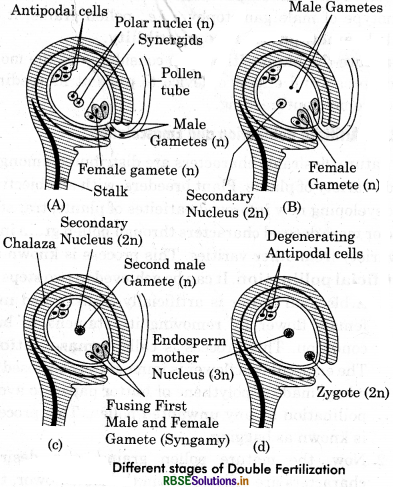
Thus, both the male gametes are involved in the act of fertilization i.e., fertilization takes place twice, that is why, it is called double fertilization. Thug, double fertilization involves both true fertilization and triple fusion. The double fertilization is usually found in all the
angiosperms. First of all double fertilization was discovered by S.G. Nawaschin (1898) in Lillium and Fritillaria.
Significance of Double Fertilization:
- Double fertilization is essential to produce viable seeds. if any one of the fertilization does not occur in an angiosperiniic plant, the viable seeds do not form.
- As a result of double fertilization, triple fusion takes place and endosperm is formed, which provides nutrition to the developing embryo so that embryo develops properly, and healthy and better seeds are formed.
Question 18.
With suitable diagram, describe the development of dicot embryo.
Answer:
First of all Hanstein (1870) studied the embryo development in Capseila bursa pastoris, a member of family Brassicaceae. It is also called onagrad type of an embryo. First of all, zygote enlarges in size and divides transversely to give rise to two cells i.e., terminal cell towards chalazal end and basal cell toward micropylar end. The basal cell near the micropylar end of embryosac, grows in size and called suspensor cell. The suspensor cell divides transversely to form a row or seven to eight cells, called suspensor. The suspensor pushes the developing embryo deep into the developing endosperm.
The first cell of the suspensor towards the micropylar end becomes swollen and form houstorial cell i.e., haustorium. It absorb food materials for the developing embryo. The last cell of suspensor adjacent to the embryo is known as hypophysis. It gives rise to the redicle and root cap. Meanwhile, the terminal or embryonal cell divides longitudinally to give rise two terminal cells. Both these further divide transversely to form a quadrant. Each cell of the quadrant divides by a transverse wall, giving rise to the octant called embryonal mass. These cells are arranged in two tiers—epibasal (terminal) and hypobasal (near the suspensor). The epibasal cells eventually form two cotyledons and a plumule. Hypobasal cells give rise to hypocotyle.
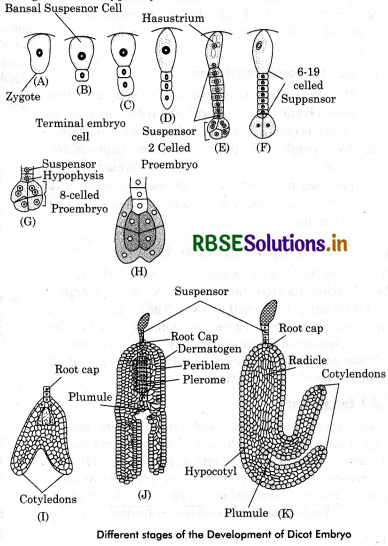
The eight embryonic cells (octants) divide periclinally to form an outer layer of dermatogen (protoderm). The inner cells differentiate further into procambium (plerome) and ground meristem (periblem). Protoderm forms the epidermis, procambium forms stele or vascular tissues and ground meristem produces pith and cortex. By further repeated divisions, the embryonal cells form globular embryo with radial symmetry, which is known as proembryo. With the evelopment of radicle, plumule and cotyledons. the proembryo transforms into an embryo. With the differentiation of two cotyledons, the embryo becomes heart shaped. The group of the cells in the groove of two cotyledons forms the plumule. The suspensor then disintegrates.
Structure of Dicot Embryo : A well developed dicot embryo consists of an embryonal axis with two cotyledons. The embryonal axis bears plumule at the apical end and the radicle at the basal end. The plumule gives rise to the shoot and the radicle develops into the root system.
Question 19.
With suitable diagram, describe the development of monocot embryo.
Answer:
B. Development of Monocot Embryo
The early stages of embryo development are very similar in both monocot and dicot plants. The main differences in the mature embryos of monocot and dicot are due to the number of cotyledons and position of plumule. The zygote elongates and then divides by a transverse wall into a basal cell and a terminal cell. The basal cell lies towards micropylar end, produces a large swollen vesicular suspensor cell, it may serve as haustorium. The terminal cell divides by another transverse wall to form two cells. The top cell, after repeated divisions forms the plumule and a single cotyledon. The cotyledon called scutellum, grows rapidly and pushes the terminal plumule to one side. The plumule comes to lie in a depression. The middle cell, after many divisions, forms the hypocotyl and radicle. A few cells are also attached to the suspensor. In some plants (such as cereals), both plumule and radicle get surrounded by sheaths developed from scutellum called coleoptile and coleorhiza respectively.
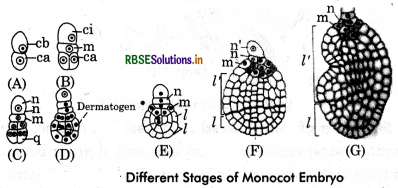
Question 20.
Give the structure of:
(a) Castor seed
(b) Maize seed.
Answer:
(a) Structure of Castor Seed: This seed is a dicotyledonous endospermic seed. It is oblong in outline with a mottled brown shining surface. Its proximal narrow and possesses a bibbed white spongy caruncle. Helium and micropyle are situated below the caruncle. Raphe runs ventrally from helium. Seed is surrounded by a hard brittle testa and a thin tegmen. Endosperm is a fleshy and oily food-storing tissue that lies inside the seed coat. Embryo lies centrally. The embryonal axis of tigellum is short with two papery whitish cotyledons, a knob-like radicle and a small plumule.
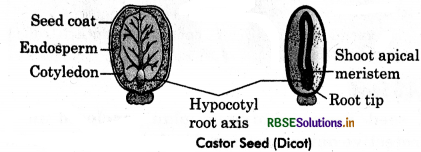
(b) Structure of Maize Seed : This seed is monocotyled onous, endospermic seed and also called grain because its fruit wall (pericarp) is fused with seed coat (testa). It is described as single seeded fruit, caryopsis. The maize seed is more or less oblong. Its flat upper surface has a light-coloured depression which marks the position of embryo within. Seed coat is outer hard covering. Formed by the fusion of pericarp and seed coat, which is yellowish-brown in colour. Endosperm is the major part of grain with stored food. It is differentiated into outer aleurone layer consists of aleurone protein and inner endosperm rich in starch. Endosperm is separated from the embryo by epithelial layer. Embryo is differentiated into scutellum and embyronal axis.
Scutellum is a shield like single cotyledon which does not store food but serve to transfer food from endosperm to growing embryo during germination. Embryonal axis is differentiated into upper plumule and lower radicle. the root cap protects the tip of radicle and is covered with a protective sheath known as coleorhiza. The plumule with a number of young leaves is ensheathed by coleoptile. The region between cotyledonary node and base of coleoptile is called the mesocotyl. It is the first internode.
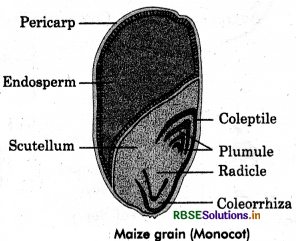

- RBSE Class 12 Biology Notes Chapter 16 पर्यावरण के मुद्दे
- RBSE Class 12 Biology Notes Chapter 15 जैव-विविधता एवं संरक्षण
- RBSE Class 12 Biology Notes Chapter 14 पारितंत्र
- RBSE Class 12 Biology Notes Chapter 13 जीव और समष्टियाँ
- RBSE Class 12 Biology Notes Chapter 12 जैव प्रौद्योगिकी एवं उसके उपयोग
- RBSE Class 12 Biology Notes Chapter 11 जैव प्रौद्योगिकी-सिद्धांत व प्रक्रम
- RBSE Class 12 Biology Notes Chapter 10 मानव कल्याण में सूक्ष्मजीव
- RBSE Class 12 Biology Notes Chapter 9 खाद्य उत्पादन में वृद्धि की कार्यनीति
- RBSE Class 12 Biology Notes Chapter 8 मानव स्वास्थ्य तथा रोग
- RBSE Class 12 Biology Notes Chapter 7 विकास
- RBSE Class 12 Biology Notes Chapter 6 वंशागति के आणविक आधार